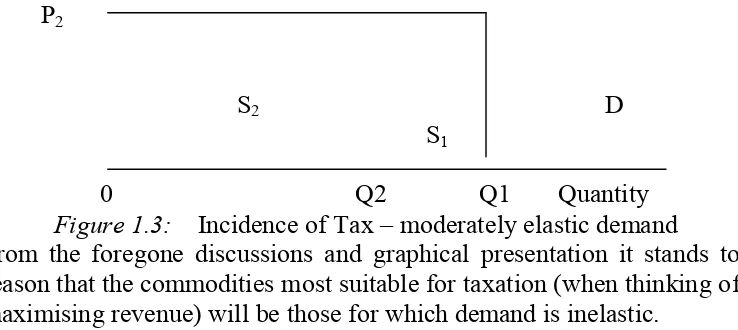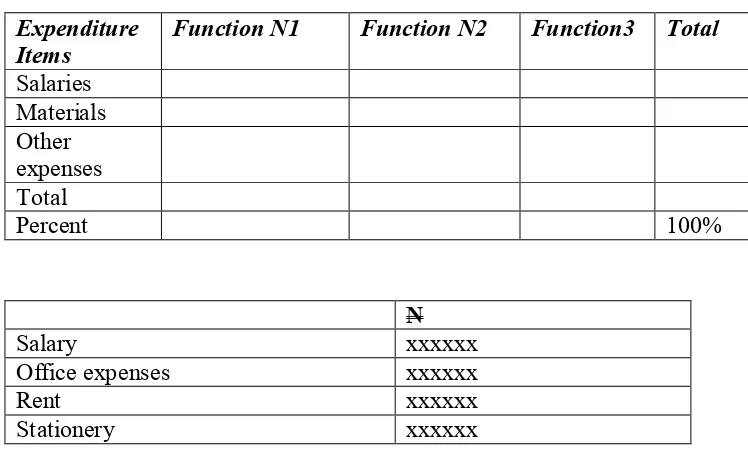NATIONAL OPEN UNIVERSITY OF NIGERIA
COURSE CODE: MPA728
COURSE TITLE:
MPA728
PUBLIC FINANCIAL MANAGEMENT
Course Team
Mr. E. U. Abianga (Developer/Writer) - NOUN
Dr. Bonaventure Nkup Haruna (Editor) - UNIJOS
Dr. Dimis I. Mai-Lafia (Programme Leader) - NOUN
Mr. E. U. Abianga (Coordinator) - NOUN
NATIONAL OPEN UNIVERSITY OF NIGERIA
COURSE
National Open University of Nigeria
Headquarters
14/16 Ahmadu Bello Way
Victoria Island
Lagos
Abuja Office
No. 5 Dar es Salaam Street
Off Aminu Kano Crescent
Wuse II, Abuja
Nigeria
e-mail:
[email protected]
URL:
www.nou.edu.ng
Published By:
National Open University of Nigeria
First Printed 2012
ISBN: 978-058-778-0
CONTENTS
PAGE
Introduction………..……….………….. 1
Course Aims………..………. 1
Course Objectives………..…………. 1
Working through This Course……….………… 1
Course Materials……….……… 2
Study Units………..……… 2
Assignment File……….………..……… 4
Presentation Schedule……….……… 4
Assessment……….…………. 5
Tutor-Marked Assignment (TMAs)………..…………. 5
Final Examination and Grading………. 6
Course Marking Scheme………. 6
Course Overview ……… 6
How to Get the Best from This Course………..……… 7
Facilitator/Tutors and Tutorials……….………… 9
Introduction
This course, MPA728 Public Financial Management in Masters in
Public Administration has been designed to give you self instruction on
the rudiments of Public Administration. It teaches you development in
public financial management in the public sector.
Course Aims
The aim of this course is to introduce you to the fundamentals of public
financial management methods and processes. It also aims at
encouraging you to acquaint yourself with the nature and scope of public
financial management.
Course Objectives
By the end of this course, you should be able to:
discuss public financial management
identify the dynamics of public financial management
define fiscal, fiscal year and explain fiscal policy
identify the primary objectives of monetary policy in Nigeria
identify the sources of government revenue
describe the distribution of review via revenue allocation
identify types and purposes of taxation in Nigeria
classify government expenditure
explain capital budgeting and its application in public sector
finance
explain the theory and practice of budgeting
discuss budgetary control functions in government sector
define public debt and identify the sources of public debt
identify government enterprises
identify different multilateral institutions and their functions.
Working through This Course
and thoughts as well as to exchange and share ideas. Below are the lists
of all the components of the course:
Course Materials
The National Open University of Nigeria will provide you with the
following items:
1.
Course Guide
2.
Study Units
3.
TMA Assignment File
In addition, at the end of every unit, is a list of texts for your references
and for further reading. It is not compulsory for you to read all of them.
They are only essential supplements to this course material.
Study Units
There are 15 units of three modules in this course.
They are as follows:
Module 1
Basics of Financial Management
Unit 1
Overview of Public Financial Management
Unit 2
Fundamentals of Public Financial Management
Unit 3
Fiscal Policy
Unit 4
Monetary Policy
Unit 5
Sources of Government Revenue
Module 2
Fiscal Federalism, Taxation and Budgeting in Public
Sector
Unit 1
Fiscal Federalism and Revenue Allocation
Unit 2
Taxation
Unit 3
Government (Public) Expenditure
Unit 4
Capital Investment Analysis in the Public Sector
Unit 5
Forms of Budgeting
Module 3
National Debts & Role of Multilateral Institutions
Unit 1
Government Budget and Budgetary Control in Public
Sector
Unit 2
Politics of Budgeting: Appropriation, Authorisation and
Control
Unit 4
Government Organisations/State Enterprises
Unit 5
Role of Multilateral Institutions – IMF, World Bank,
ADB, etc
In Module 1, the first unit introduces you to the definition of finance and
public financial Management. It also identifies the various types of
financial management and finally discusses public financial
management.
Unit 2 exposes you to the understanding of the fundamentals of how the
system were designed, what it was intended to do, what it is capable of
doing and especially what it is not capable of doing. Unit 3 exposes you
to the nature and meaning of fiscal, fiscal year and fiscal policy. You
will also learn about the identification of major instruments of fiscal
policy, the fiscal system in Nigeria, and finally, the distribution of
functions among the tiers of government.
Unit 4 deals with the monetary policy generally, which complements the
fiscal policy as a tool for economic balance in a nation. Monetary
policy is concerned with discretionary control of money supply by the
monetary authorities (Central Bank of Nigeria with the Central
Government) in order to achieve the stated or desired economic goals.
Unit 5 introduces you to the two main sources of government revenue
classified as: oil and non-oil, though governments have other means of
sourcing for funds for financing their spending requirements.
In Module 2, Unit 1 tells you about the adoption of a federal system of
political administration with fundamental implications for fiscal system
and economic management of a country through revenue allocation
formula. Unit 2 discusses the brief historical perspective of the general
principles of taxation in Nigeria, types and the purpose, incidence and
canons of taxation with current development to support.
Unit 3 focuses on the expenditure of government in Nigeria and the
classification and types of revenue as they affect different levels of
government. You have to study this unit closely in order to identify the
broad parts of public expenditure. Unit 4 discusses capital budgeting via
cost-benefit analysis as applied to the public sector. The private sector
objective is always expressed in financial terms while the principal
objective of a public sector enterprise is not necessarily financial.
Political and social considerations override financial objective in the
public sector.
economy like Nigeria. Budget is presented as a major financial
management tool.
Module 3, Unit 1 explains budgeting in government and budgetary
control as a primary device for ensuring compliance in public sector
funding. The decisions are based on available policy thrust of the
government on such funding. Unit 2 introduces you to the politics of
budgeting. The unit explains the game behind budgeting in politics
which is seen to be a universal language for an advances stage or level
of democracy, whether it is a developed or developing economy.
Unit 3 discusses national debt and the management strategy of the public
debt. You will be led into the gaps that led to the national indebtedness
and the agencies. Unit 4 deals with the significance of government
organisations as product of growth and service delivery to satisfy the
community. The main thrust for state involvement is usually public
interest.
In Unit 5, you will learn about the role of multilateral institutions that
help in underwriting external debt of nations in international trade and
enhancing the expansion and development of the respective economies
thereof. Their functions and funding strategies as well as lending/
borrowing activities of these institutions are briefly explained.
Assignment Files
You will find the assignment questions for each Tutor Marked
Assignment (TMA) in the folder labeled “Assignment File.” You will
find the details of the work. You must submit to your tutor in the file.
The marks you obtain in these assignments and how much time you
should spend on each study unit, period for revision and tutorial dates
can be found in the folder.
Presentation Schedule
The presentation schedule included in your course materials gives you
the important dates for this year for the completion of tutor-marked
assignments and attending tutorials. Remember, you are required to
submit all your assignments by the due date. You should guard against
falling behind in your work.
Assessment
Within each unit are self-assessment exercises, which are aimed at
helping you to check your assimilation as you proceed. Try to attempt
each of the exercises before finding out the expected answers from
lecture.
In tackling the assignments, you are advised to be sincere in attempting
the exercises; you are expected to apply information, knowledge and
techniques gathered during the course. The assignments must be
submitted to your tutor for formal assessment in accordance with the
deadlines stated in the
Presentation Schedule
and the
Assignment File
.
The work you submit to your tutor for assessment will count for 30% of
your total Course mark.
At the end of the course, you will need to sit for a final written
examination of ‘three hours’ duration. This examination will also count
for 70% of your total course mark.
Tutor-Marked Assignment
(TMAS)
This is your continuous assessment and accounts for 30% of your total
score. You are expected to answer at least four TMA’s, three of which
must be answered and submitted before you sit for the end of course
examination. Your Facilitator will give you the TMA’s and you must
submit to your Centre your responses.
Assignment questions for the units in this course are contained in the
Assignment File
. You will be able to complete your assignment from
the information and materials contained in your reading, references and
study units.
However, it is desirable in all degree level education to demonstrate that
you have read and researched more widely than the required minimum.
Using other references will give you a broader viewpoint and may
provide a deeper understanding of the subject.
When you have completed each assignment, send it together with a
TMA (tutor-marked assignment) form, to your tutor. Make sure that
each assignment reaches your tutor on or before the deadline given in
the
Presentation Schedule
and
Assignment File
.
Final Examination and Grading
With this examination written successfully, you have completed your
course in Basic research and one believes you would apply your
knowledge (new or up-graded) in your project. The ‘end of course
examinations’ would earn you 70% which would be added to your TMA
score (30%). The time for this examination would be communicated to
you.
Course Marking Scheme
Total Course Marking Scheme
ASSESSMENT
MARKS
Assignments 1 – 5 Fifteen assignments, best three marks of the five
count @ 10% each = 30% of course marks
Final Examination
70% of overall course marks
Total
100% of course marks
Course Overview
This table brings together the units, the number of weeks you should
take to complete them and the assignments that follow them.
Unit Title of Work Weeks
Activity
Assessment (end of unit)
Module 1
1 Overview of Public Finance 1 Assignment 1
2 Fundamentals of Public Finance 1 Assignment 2
3 Fiscal Policy 1
4 Monetary Policy 1 Assignment 3
5 Sources of Government Revenue 1 Assignment 4
Module 2
1 Fiscal Federalism and Revenue Allocation
1 Assignment 5
2 Taxation 1
3 Government (Public) Expenditure 1 Assignment 6 4 Capital Investment Analysis in the
Public Sector
1
5 Forms of Budgeting 1 Assignment 7
Module 3
Management
4 Government Organisations/State Enterprises
1
5 Role of Multilateral Institutions – IMF, World Bank, ADB, etc.
1 Assignment 10







